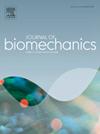在跑步机带速度扰动下,弹性髋外骨骼对机械能量学和全身角动量量化的稳定性的影响
IF 2.4
3区 医学
Q3 BIOPHYSICS
引用次数: 0
摘要
相对于电动设备,具有弹性驱动的被动髋关节外骨骼提供了更便宜和更低调的解决方案,以辅助行走时的运动。然而,髋关节弹性辅助对行走稳定性的影响尚不清楚。在这里,我们研究了在站立后期提供弹性屈曲扭矩的髋关节外骨骼对稳定性的影响。我们对11名健康的未受伤个体进行了量化,使用矢状面全身角动量(WBAM)范围和全身机械功来测量他们在意想不到的前后跑步机带加速度下行走时的稳定性。我们假设,在扰动期间,1)弹性髋关节外骨骼可以提高稳定性,通过测量矢状面WBAM的较小范围和扰动施加的较低的全身能量需求来衡量;2)全身能量需求的改善将通过外骨骼改变髋关节的局部机械能量来调节,以对抗扰动的能量需求。与我们的假设相反,弹性髋外骨骼不会影响扰动施加的全身工作需求(p>0.226)。此外,尽管矢状面WBAM范围在未受干扰的行走过程中较大,但由于躯干运动学的改变,外骨骼刚度增加(p<0.001),这种影响不会延伸到受干扰的行走中(p>0.419)。此外,虽然较高的外骨骼刚度(0.66-1.0 Nm/度)使同侧髋关节的工作与全身工作需求相反,但相同的刚度使对侧髋关节的工作向全身工作需求转变。我们的研究结果表明,从矢状面WBAM范围得出的稳定性结论并不能从无扰动的行走延续到扰动的行走。本文章由计算机程序翻译,如有差异,请以英文原文为准。
Effects of an elastic hip exoskeleton on stability quantified by mechanical energetics and whole-body angular momentum during walking with treadmill belt speed perturbations
Relative to motorized devices, passive hip exoskeletons with elastic actuation provide cheaper and lower-profile solutions to assist locomotion during walking. However, the influence of elastic hip assistance on stability during walking is poorly understood. Here, we investigated the effects on stability of a hip exoskeleton that provided elastic flexion torque during late stance. We quantified stability using both sagittal whole-body angular momentum (WBAM) range and whole-body mechanical work during walking with unexpected anteroposterior treadmill belt accelerations among 11 healthy uninjured individuals. We hypothesized that during perturbations, 1) an elastic hip exoskeleton would improve stability as measured by a smaller range in sagittal WBAM and a lower whole-body energetic demand imposed by the perturbation, and 2) this improvement in whole-body energetic demand would be mediated by the exoskeleton shifting the local mechanical energetics of the hip joint to oppose the energetic demands of the perturbation. Contrary to our hypotheses, the elastic hip exoskeleton did not influence whole-body work demands imposed by perturbations (p>0.226). Additionally, while sagittal WBAM ranges were larger during unperturbed walking with increasing exoskeleton stiffness due to alterations in trunk kinematics (p<0.001), this effect did not extend to perturbed walking (p>0.419). Further, while higher exoskeleton stiffnesses (0.66–1.0 Nm/deg) shifted ipsilateral hip joint work in opposition to whole-body work demands, the same stiffnesses shifted contralateral hip joint work toward whole-body work demands. Our findings demonstrate conclusions drawn about stability from sagittal WBAM range do not carry over from unperturbed to perturbed walking.
求助全文
通过发布文献求助,成功后即可免费获取论文全文。
去求助
来源期刊

Journal of biomechanics
生物-工程:生物医学
CiteScore
5.10
自引率
4.20%
发文量
345
审稿时长
1 months
期刊介绍:
The Journal of Biomechanics publishes reports of original and substantial findings using the principles of mechanics to explore biological problems. Analytical, as well as experimental papers may be submitted, and the journal accepts original articles, surveys and perspective articles (usually by Editorial invitation only), book reviews and letters to the Editor. The criteria for acceptance of manuscripts include excellence, novelty, significance, clarity, conciseness and interest to the readership.
Papers published in the journal may cover a wide range of topics in biomechanics, including, but not limited to:
-Fundamental Topics - Biomechanics of the musculoskeletal, cardiovascular, and respiratory systems, mechanics of hard and soft tissues, biofluid mechanics, mechanics of prostheses and implant-tissue interfaces, mechanics of cells.
-Cardiovascular and Respiratory Biomechanics - Mechanics of blood-flow, air-flow, mechanics of the soft tissues, flow-tissue or flow-prosthesis interactions.
-Cell Biomechanics - Biomechanic analyses of cells, membranes and sub-cellular structures; the relationship of the mechanical environment to cell and tissue response.
-Dental Biomechanics - Design and analysis of dental tissues and prostheses, mechanics of chewing.
-Functional Tissue Engineering - The role of biomechanical factors in engineered tissue replacements and regenerative medicine.
-Injury Biomechanics - Mechanics of impact and trauma, dynamics of man-machine interaction.
-Molecular Biomechanics - Mechanical analyses of biomolecules.
-Orthopedic Biomechanics - Mechanics of fracture and fracture fixation, mechanics of implants and implant fixation, mechanics of bones and joints, wear of natural and artificial joints.
-Rehabilitation Biomechanics - Analyses of gait, mechanics of prosthetics and orthotics.
-Sports Biomechanics - Mechanical analyses of sports performance.
 求助内容:
求助内容: 应助结果提醒方式:
应助结果提醒方式:


